- 1Animalfree Research, Bern, Switzerland
- 2Environmental Sciences and Humanities Institute, University of Fribourg, Fribourg, Switzerland
- 3Oxford Centre for Animal Ethics, Oxford, United Kingdom
Animal dissection has been a traditional teaching tool in biology for centuries. However, harmful animal use in education has raised ethical and environmental concerns in the last decades and led to an ongoing debate about the role and importance of animal dissection in teaching across all education levels. To understand the current status of dissection in secondary education and the attitudes toward humane teaching alternatives among the educators, I conducted a survey–for the first time–among high school biology teachers in Switzerland. The specific aims of this study were (i) to explore the extent of animal or animal parts dissection in high school biology classes, (ii) to understand the attitudes and experiences of high school biology teachers toward dissection and animal-free alternatives, and (iii) to gain some insight into the circumstances hindering a wider uptake of alternatives to animal dissection in high school education. In total, 76 teachers participated in the online survey. The vast majority (97%) of the participants reported using animal dissection in their classes. The responses also revealed that a large proportion of the teachers consider animal-free alternatives inferior teaching tools in comparison with dissection. As the obstacles to adopting alternatives were most often listed the lack of time to research other methods, high costs, and peer pressure. In conclusion, the wider uptake of humane teaching methods would require financial support as well as a shift in the attitudes of high school biology teachers.
Introduction
Harmful animal use in education has been a controversial issue, raising ethical and environmental concerns (Hug, 2008) as well as concerns about the potential psychological impact on students (Capaldo, 2004). The discussion so far has focused mostly on tertiary education (Knight, 2007, 2014; Zemanova, 2021; Zemanova and Knight, 2021). However, animals are not only being used in human or veterinary medicine training at universities but also as a part of general biology education in high schools. This tradition began in the early 1900s (Kinzie et al., 1993) and is still present in many countries, despite the many available animal-free alternatives (Balcombe, 2001) and legislation requiring replacement of animal use for scientific purposes–including teaching and training–whenever possible (e.g., the EU Directive 2010/63 or the Swiss Animal Welfare Act).
Humane alternatives to harmful animal use in education, such as videos, books, virtual dissections, or plastic 3D models, have been implemented since at least the 1960s (de Villiers and Monk, 2005) and have been shown to produce equivalent or even superior learning outcomes (Knight, 2007; Patronek and Rauch, 2007; Zemanova and Knight, 2021). Nevertheless, as the number of animals used for teaching and training purposes remains relatively high (Zemanova et al., 2021), there is a chasm between the evidence of the efficacy of humane teaching methods and the continued implementation of harmful animal use in education.
Many factors can influence teachers’ decisions on whether to use animal dissection or humane alternatives, for example, their own education, previous experience with animal-free teaching methods, or school guidelines (Oakley, 2012b). Nevertheless, up to date, only a few studies investigated the attitudes and experiences of high school biology teachers toward animal dissection (King et al., 2004; de Villiers and Sommerville, 2005; Oakley, 2012b; Kavai et al., 2017).
Therefore, this study aimed to evaluate, for the first time, the experiences and attitudes of the Swiss high school teachers toward the use of dissection and animal-free alternatives. Specifically, the survey intended to determine (1) the extent to which animals or animal parts are being used in biology classes in Swiss high schools, (2) whether Swiss high school teachers embrace and adopt animal-free alternatives, and (3) the attitudes of teachers toward dissection and humane teaching methods. The exploration of teachers’ attitudes toward dissection and alternatives can provide a clearer picture about the barriers and opportunities for making the shift toward more humane biology education (Oakley, 2012b).
Materials and Methods
Survey Design
An online survey was designed using the platform Typeforms1 to obtain anonymous responses from high school biology teachers in Switzerland. Questions were written in German and organized into two parts: (1) a general part with questions about demographic data of the respondents, and (2) a scientific part with questions on the use of animal or animal organ dissection in their teaching practice. The survey contained a combination of open-ended questions and multiple-choice questions, allowing respondents to check one or more boxes from a list of possible answers. Attitudes were measured on a five-point Likert scale (Likert, 1932). The first version of the survey was launched in August 2019 and an updated version with several additional questions was launched again in June 2021. Each time, the survey stayed open for responses for 12 weeks.
Survey Distribution and Administration
Email invitations to participate in the survey, together with a link to the anonymous online questionnaire, were distributed through emailing the administration offices of 162 high schools across 26 Swiss cantons, asking for forwarding the email to the biology teachers at their school. Schools were identified through the Swiss Rectors Association and their number represents approximately 10% of all secondary schools in Switzerland (Federal Statistical Office, 2022). Respondents were also recruited through an announcement on social media and through contacting the organizations Teachers Switzerland, Association of Swiss Science Teachers, and Association of Swiss Gymnasium Teachers. Consequently, it was not possible to control how many invitation emails reached potential respondents and to calculate the response rate.
Statistical Analysis
Descriptive statistics, including bar plots and a frequency table, were used to summarize the responses. The Pearson’s chi-squared test was used to assess any potential influence of the demographic characteristics (age, gender) on the attitudes. Significance for all levels was set at p < 0.05. All statistical analyses were conducted in R 4.1.3 (R Core Team, 2022) integrated in RStudio 2022.02.1 (Rstudio Team, 2022).
Results
Demographic Characteristics
A total of 76 teachers, 22 in 2019 and 54 in 2021, completed the survey. Both genders were almost equally represented (Figure 1A), reflecting the average gender distribution among high-school teachers across Switzerland (Federal Statistical Office, 2021). One third of the respondents belonged to the age category 20–35 years old, 40% to the age bracket 36–45 years old, 22% to 46–55 years old, and 8% to 56–65 years old (Figure 1B). The majority of the respondents taught at a grammar school (gymnasium) and worked in the primarily German-speaking cantons (Figures 1C,D).
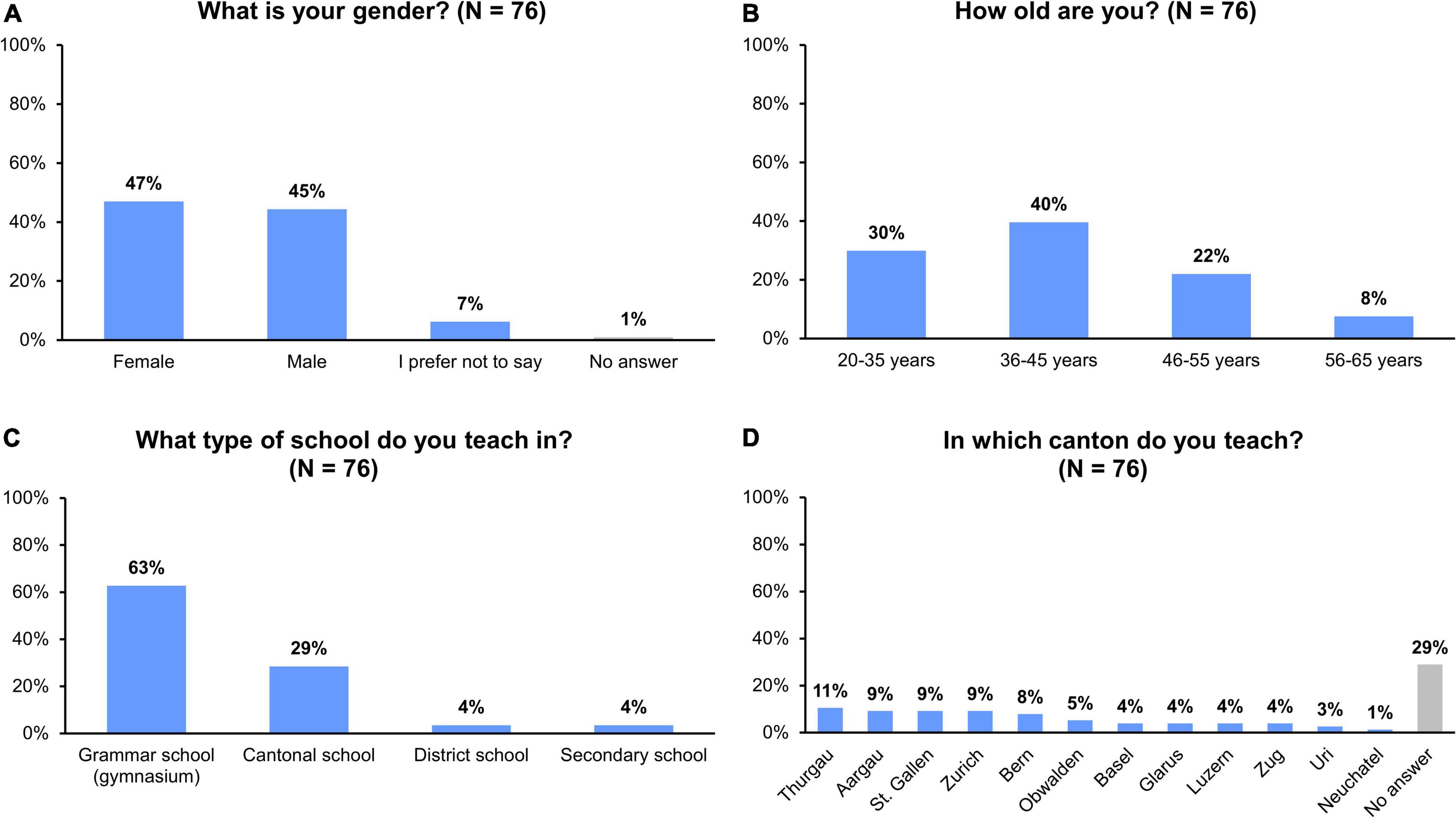
Figure 1. (A) Gender of the respondents participating in the survey. (B) Age of the respondents participating in the survey. (C) Type of school the respondents teach in. (D) Swiss canton the respondents teach in.
Prevalence of Dissection, Species Used, and Availability of Animal-Free Alternatives
Almost all of the respondents (91%) performed dissection of animals or animal parts during their own education, of which only a minority (4%) reported negative experiences associated with dissection (Figure 2A). The majority (94%) also stated that they can decide whether to include dissection in their teaching (Figure 2B). Out of 76 teachers, only two do not use dissection in their science classes (for ethical reasons; Figure 2C). Over one third of the teachers participating in the survey start including dissection in biology classes in grade 7 (Figure 2D), which in the Swiss educational system corresponds to the age group of 12- or 13-year olds.
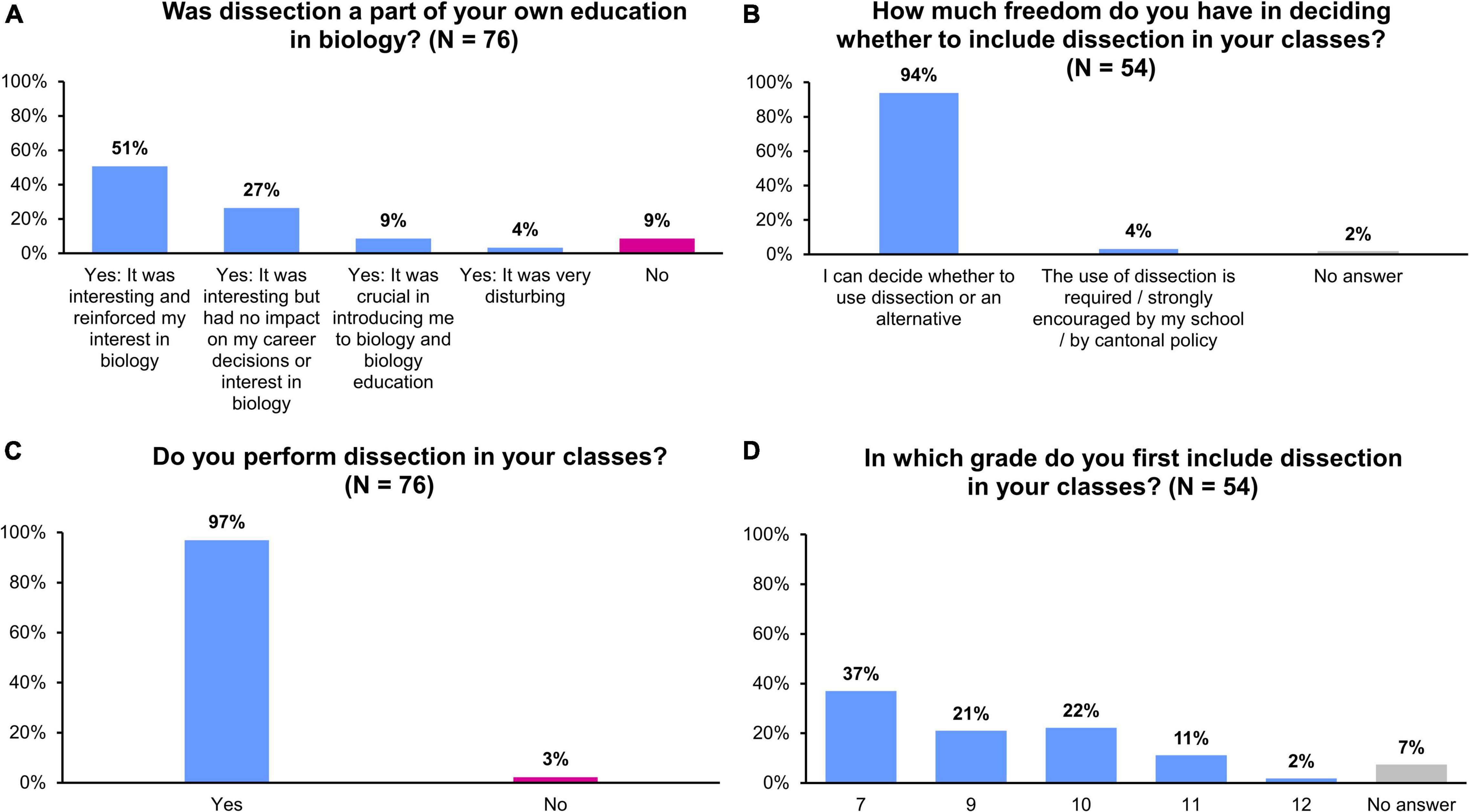
Figure 2. (A) Experience with dissection in respondents’ own education. (B) Extent to which the respondents can decide whether to include dissection in their teaching. (C) Use of animal dissection in biology classes. (D) School grade in which the respondents first include dissection in their teaching.
Most commonly used in dissection classes are animal organs, such as a heart or an eye, fish, insects, earthworms, and squids (Figure 3A). The teachers usually get this material from the butcher, at pet stores, or they collect animals in nature (Figure 3B). According to the teachers, the most important thing that students can learn from dissection is anatomy, 3D experience, recognition of the complexity of reality, or ethics, and respect toward animals (Figure 3C).
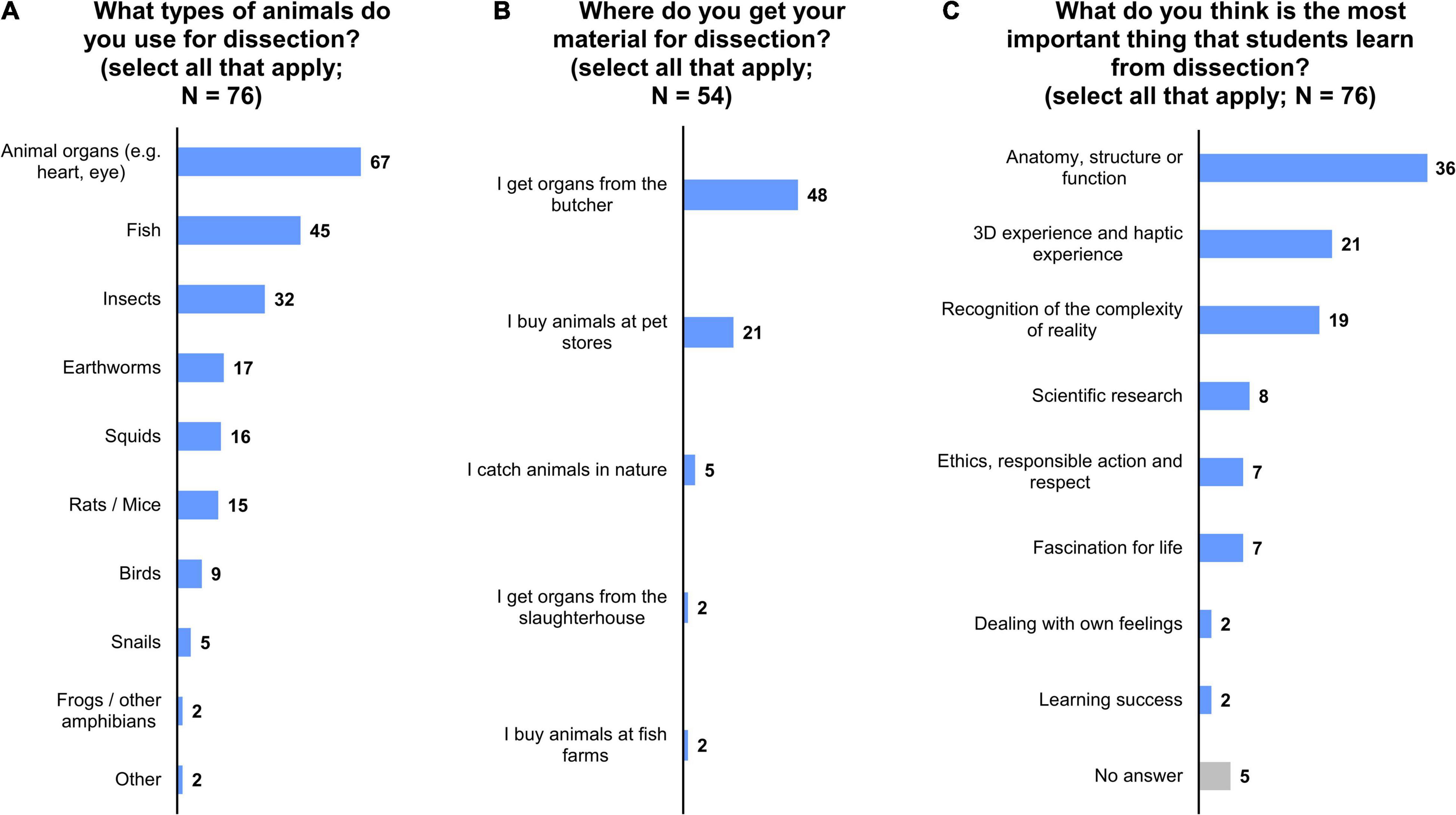
Figure 3. (A) Type of animals used in dissection classes. (B) Source of animals used in dissection classes. (C) The most important learning outcome of dissection exercise.
The teachers actively allow their students to opt out, despite the teachers’ limited experience with alternatives that they could provide to their students (Figures 4A,B). The teachers stated that only a minority of students–regardless of their gender–chooses not to participate in dissection (Figures 4C,D). As the reasons of students for not wanting to participate were listed most often nausea or disgust, strong respect for animals, and religion or worldview (Figure 5A). If a student decides not to participate in dissection, the most frequently offered alternative is the observation of other students performing dissection, followed by videos or photos. Some teachers also use virtual dissection as an alternative (Figure 5B).
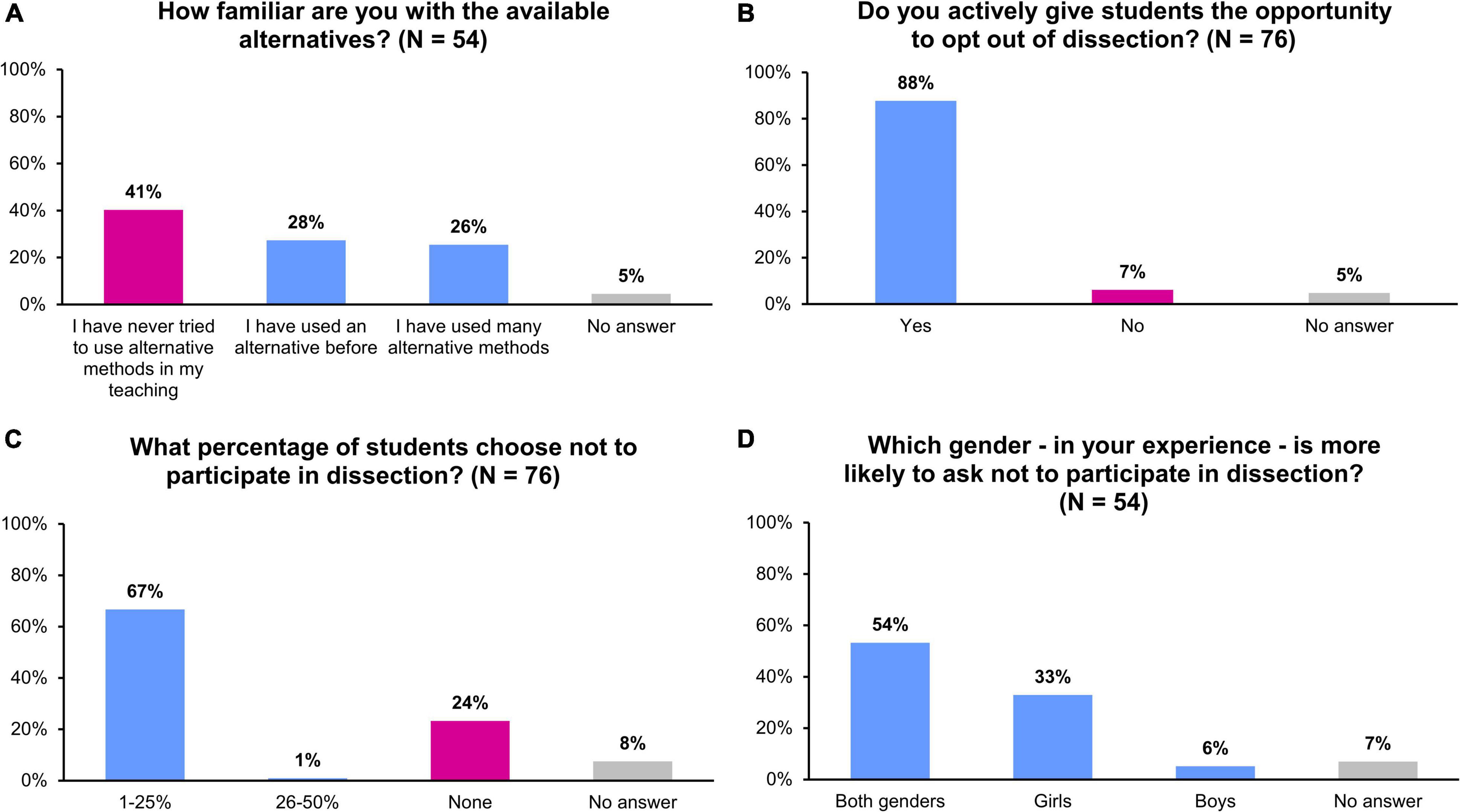
Figure 4. (A) Familiarity of the respondents with the available animal-free alternatives. (B) Proportion of the respondents giving their students actively the opportunity to opt out of dissection. (C) Estimated proportion of students opting out of dissection. (D) Gender distribution among students refusing to participate in dissection.
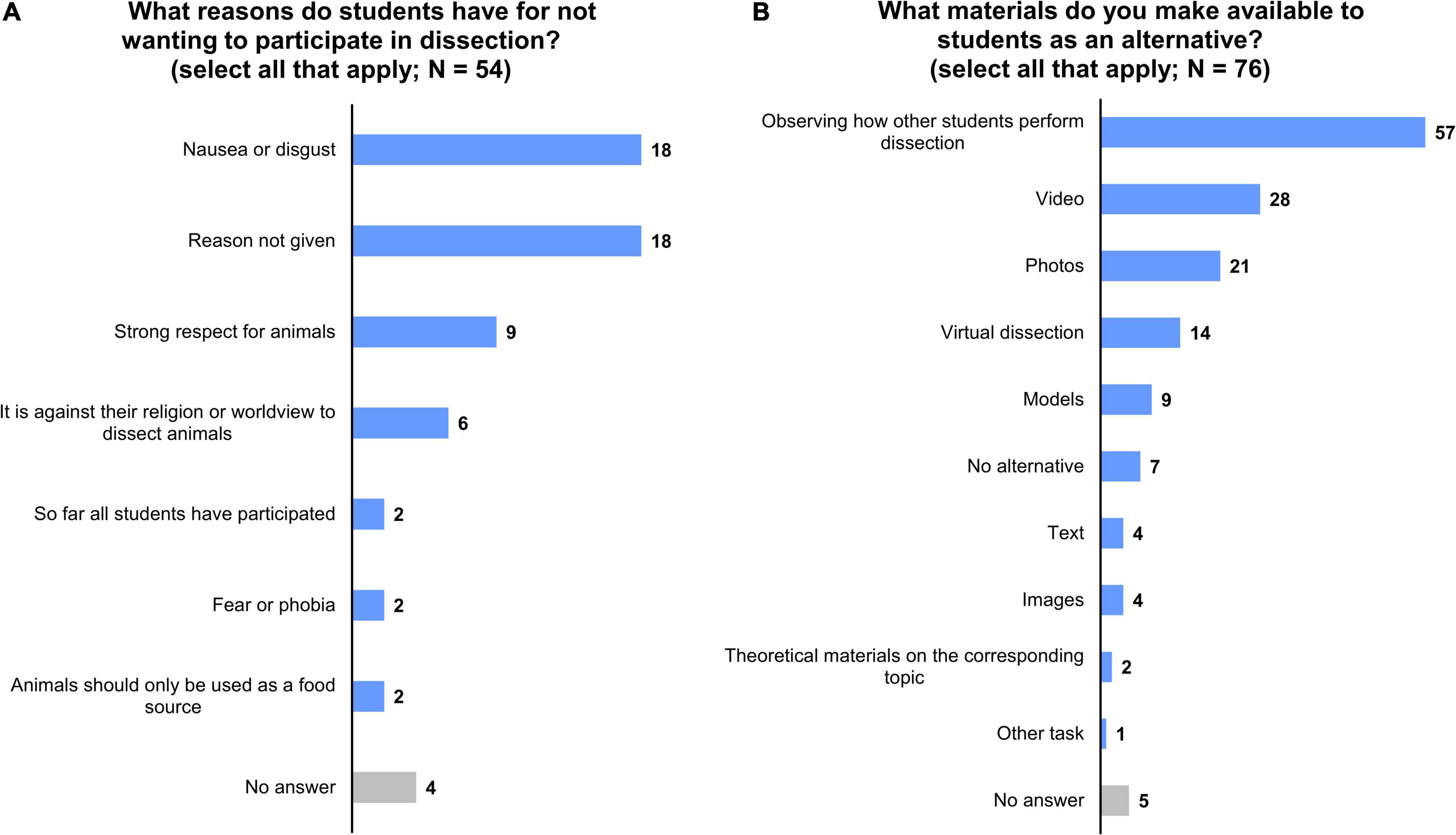
Figure 5. (A) Reasons of students for not participating in dissection. (B) Alternatives provided by the respondents to students not wanting to participate in dissection.
The respondents were also asked what they perceived as the barriers to implementing animal-free alternatives. The majority of the respondents do not find animal-free alternatives as good for education as the use of real animals (Figure 6A and Table 1). The teachers also reported having little time to research appropriate alternative teaching methods and that alternatives are too expensive (Figure 6A). Consequently, what would teachers need to make the shift away from using animals are high-quality alternatives, more time for the preparation of classes with alternative methods, and a higher budget (Figure 6B).
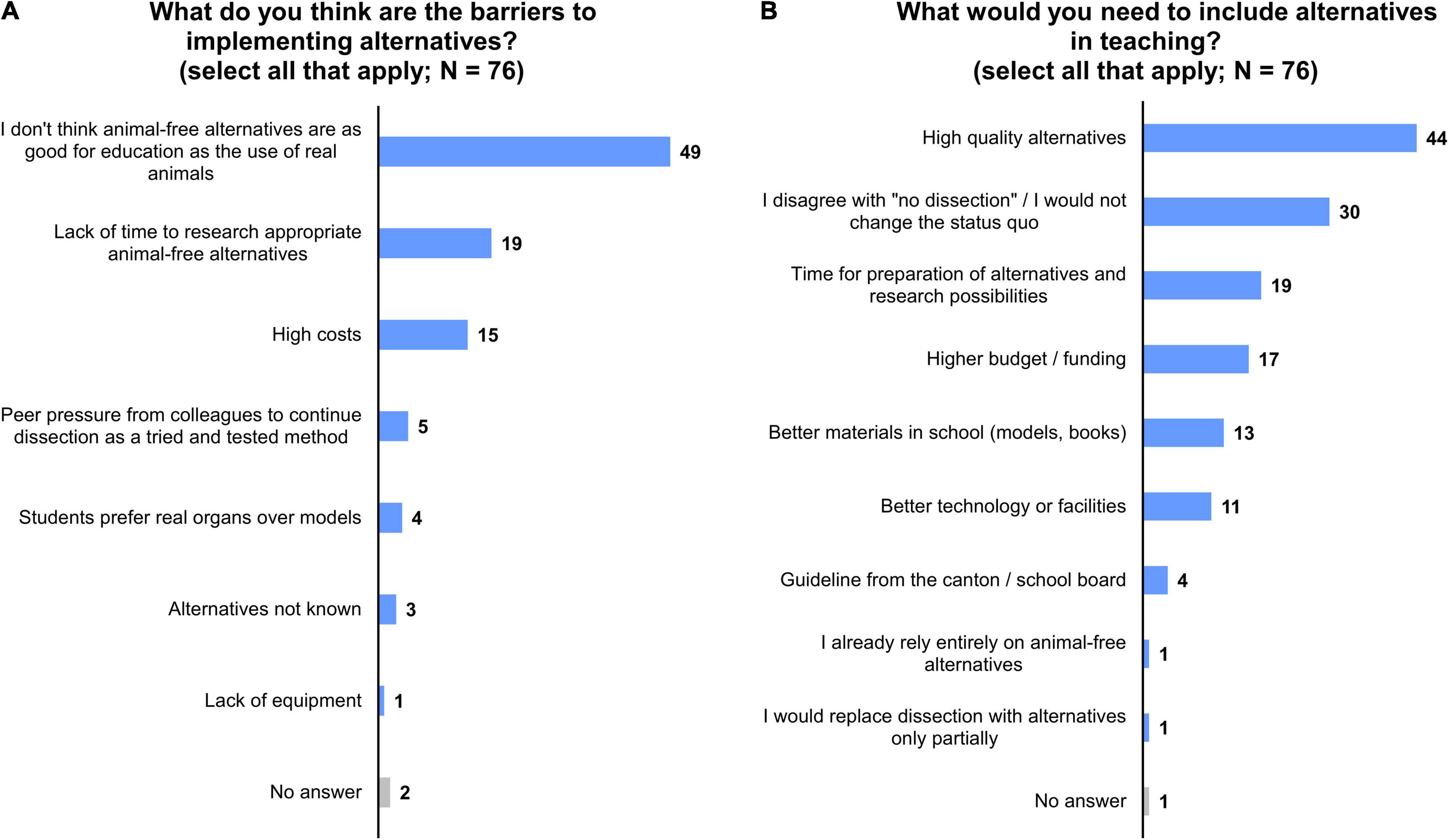
Figure 6. (A) Perceived barriers to implementing animal-free alternatives instead of animal dissection. (B) Needs of the respondents that would have to be met in order to include animal-free alternatives in their teaching practice.
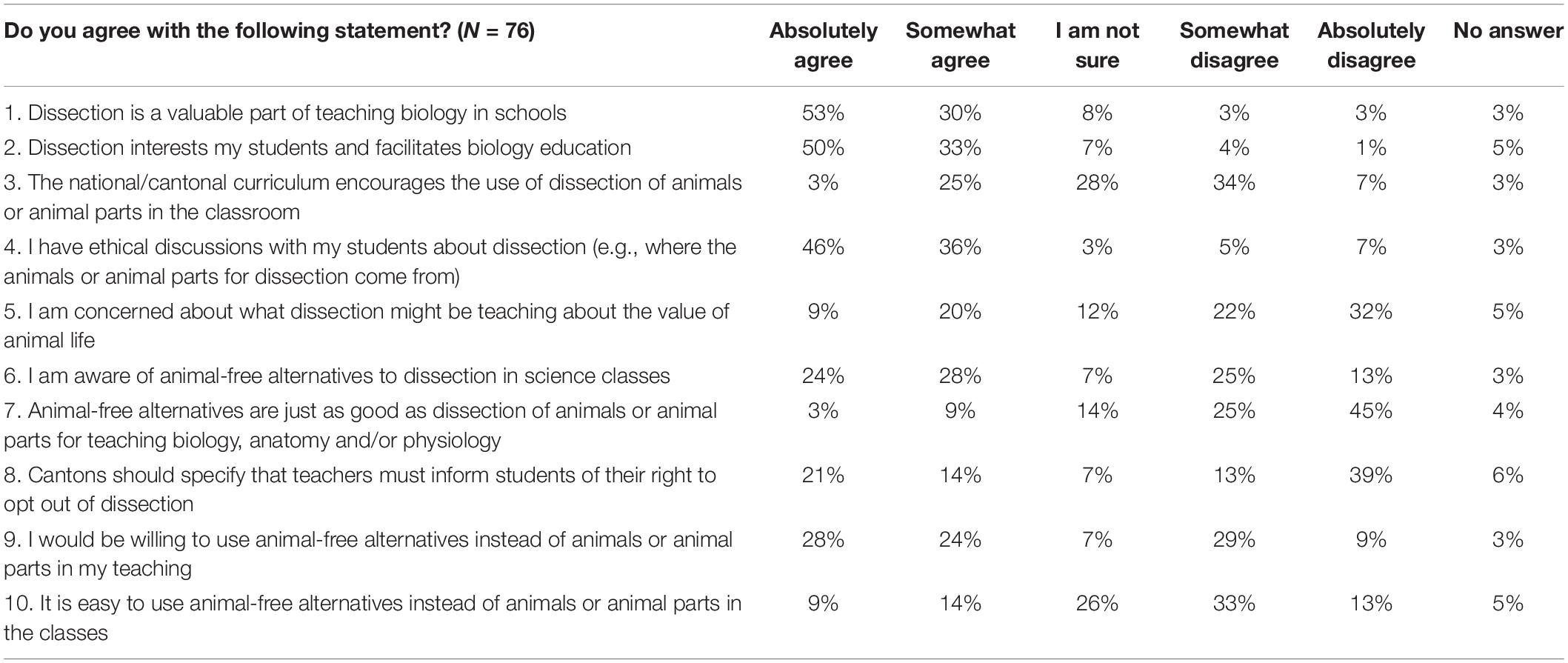
Table 1. Percentage of teachers who agreed or disagreed with the following statements regarding the use of dissection and alternatives.
Teachers’ Attitudes Toward Animal Dissection and Animal-Free Alternatives
The majority of the teachers (83%) participating in the survey agreed or strongly agreed with the statement that dissection is a valuable part of teaching biology in schools (83%; Table 1) and that dissection interests their students (83%; Table 1). More than a half of the teachers are aware of the available animal-free alternatives, but 70% disagreed with the statement that alternatives are just as good as animals or animal parts for teaching biology (Table 1). While 52% of the teachers would be willing to use an alternative in their teaching, 46% stated that it is not easy to do so (Table 1). Lastly, more than half of the teachers disagreed with the statement that cantons should specify that teachers must inform students of their right to opt out of dissection (Table 1). There was no statistically significant influence of the age on the attitude toward animal dissection and alternatives. Only two statements elicited different responses between genders: women expressed concern about what dissection might be teaching the value of animal life more frequently than men (statement nr. 5 in Table 1; p = 0.019) and were more willing to use animal-free alternatives instead of animals in their teaching (statement nr. 9 in Table 1; p = 0.028).
Discussion
Prevalence of Animal Dissection at Swiss High Schools
Although in the literature Switzerland has been repeatedly listed as one of the five countries–together with Argentina, Israel, Netherlands, and Slovakia–that prohibits dissection below the university level (Waltzman, 1999; Balcombe, 2000; Oakley, 2012b; Sathyanarayana, 2013; Osenkowski et al., 2015), this survey showed that dissection of animals or animal parts at Swiss high schools remains prevalent. Out of 76 teachers participating in the survey, only two (i.e., 3%) do not use animal dissection in their teaching practice (Figure 2C).
These results are analogous to findings described from other countries. In King et al. (2004) the authors reported that out of 494 American teachers participating in their survey, 79% used dissection in their classes. A more recent study from the United States by Osenkowski et al. (2015) described similar results: out of 1,178 teachers, 84% reported using dissection in biology education. The survey by de Villiers and Sommerville (2005) of 242 prospective biology teachers at a South African university found that 71% would expect their students to dissect animals in their classroom.
Type and Source of Animals Used in Dissection
In the survey, teachers reported that animal organs, fish, and insects are used most frequently in dissection (Figure 3A). At American high schools, frogs, fetal pigs, and earthworms are the most common material (King et al., 2004; Osenkowski et al., 2015). In the United States, it has been estimated that 99% of animals used in biology classes for dissection are caught in the wild (Environmental Magazine, 2004), which might mean that the size of the local population might severely decline over time, and potentially lead to an imbalance within the ecosystem. In contrast, Swiss teachers usually get the dissection material from the butcher, animal pet stores, and only 9% of the respondents stated that they also catch animals in nature (Figure 3B).
Pedagogical Value of Animal Dissection
The teachers participating in the survey were asked what, in their opinion, dissection teaches. Among the primary goals for the dissection exercise were stated learning anatomy, having the 3D experience, and recognition of the complexity of reality (Figure 3C). Similar responses were reported also from previous studies (Kavai et al., 2017). The American Psychological Association states that animal dissection “engenders creativity, original thought, critical thinking, and problem-solving skills” (American Psychological Association, 2017). Oakley (2012b) reported that some teachers are convinced that the use of animals in education might in fact teach students about the ethics of using animals in research. Indeed, several teachers in my study mentioned ethics, responsible action, respect for animals, and fascination for life as the educational outcomes (Figure 3C).
However, it has been argued that dissection can encourage a decreased sensitivity toward animal life. Solot and Arluke (1997) observed sixth-grade students during fetal pig dissection. They found that many students described themselves as becoming “immune” or “adapted” to the situation, i.e., appearing hardened by the activity as the dissection progressed. Sabloff (2001) postulated that through dissection, animals become positioned as “artifacts,” meaning that they are considered (1) made for human use, (2) not sentient, (3) discardable, and (4) excluded from the moral community. And Sapontzis (1995) suggested that dissection teaches students that an animal can be killed for “trivial” purposes such as curiosity or tradition.
Furthermore, over the last 100 years, the focus of biology has shifted from anatomy to cellular level and genetics (Oakley, 2009). In contrast, the practice of dissection in high schools is almost 100 years old and it is questionable whether it remains a valid representation of contemporary biology (Hart et al., 2008; Oakley, 2009). Hug (2005) suggests that dissection might have become a ritual of science carried out without critical evaluation of its usefulness. Only a part of high school students would eventually enroll in university courses that relate to the experience of dissection, e.g., veterinary medicine, for the majority of students the dissection experience will have no relevance for their future career (Orlans, 1993). In addition, there have been contradicting opinions voiced about whether dissection encourages or discourages students to eventually pursue a career in science. Several studies reported that dissection can and does turn some students from life sciences (Balcombe, 2000; Bishop and Nolen, 2001).
Proportion of Students Opting Out of Animal Dissection
While the majority of the teachers participating in the survey actively allow their students to opt out of dissection, 7% of the teachers do not (Figure 4B). According to the teachers’ statements, only a minority of students opt out of dissection practice (Figure 4C). Previous studies have estimated that in a typical class, 3–5% of the students will openly object to dissection (Balcombe, 2000; Hart et al., 2008; Spernjak and Sorgo, 2017).
Balcombe (1997) stated that “perhaps the most misunderstood aspect of the animal dissection issue is the number of students who openly object to the practice.” Students may not voice their preference due to fear of embarrassment in front of their peers, fear of a failing grade, or fear of challenging the teacher’s authority (Balcombe, 2000). Consequently, it is assumed that only a minority of the students objecting to dissection expresses their concerns and opinions openly. This was reported also in the study by Oakley (2012a), which showed that the actual proportion of students harboring objections to dissection is higher than the proportion that voiced their opinion.
Whereas some authors claim that using dissection provides high school students with an “exciting” education experience (Barr and Herzog, 2000), it is important to note that dissection may not be enjoyable for every student. There have been published several studies investigating the attitudes of high school students toward dissection. For instance, the study carried out by Stanisstreet et al. (1993) found that 48% of 420 students from three different secondary schools in the United Kingdom considered the dissection of animals for teaching purposes to be wrong. Another study of 85 students aged 15–16 reported that over a third of the respondents felt that dissection is disrespectful to the animal (Doster et al., 1997). A retrospective survey of 191 undergraduate students reported that 27% of them experienced negative emotional reactions to dissection in high school (Bowd, 1993).
Randler et al. (2016a) used a dissection video clip shown before the dissection of a fish to reduce anxiety among students. In another study, Randler et al. (2016b) employed humor to reduce anxiety and disgust. Nevertheless, such strategies should not be encouraged as seeing their classmates joke during dissection can be very uncomfortable for other students (Tolbert, 2019). Since this study was limited to surveying the experience and attitudes of teachers, further research elucidating the Swiss students’ perspective on dissection is warranted.
Teachers’ Experience With and Attitudes Toward Animal-Free Alternatives
Animal dissection practice seems to be deeply ingrained in the Swiss educational system. The majority of teachers were taught through dissection (Figure 2A) and continue to demonstrate the biological concepts in this “traditional” way (Figures 2B–D). This prevalence of dissection can be attributed to strong opinions about the efficacy and usefulness of animal-free alternatives exposed in the responses. The very slight gender difference in attitudes is consistent with previous studies, showing that women express concern for animal welfare and suffering more frequently and to a greater extent than men (Herzog, 2007; Phillips et al., 2011; Zemanova, 2021).
Similarly to previous studies (Oakley, 2012b), my survey revealed that teachers continue to perceive dissection as the best way for students to learn biology (Figure 6A and Table 1). While the majority of teachers responding to the survey found that alternatives are not as good material for learning as animal dissection, alternatives have been shown to have equivalent or higher efficacy in providing the intended learning outcomes than harmful animal use (Zemanova and Knight, 2021). Humane teaching methods offer also other benefits. They are often less expensive, require less preparation and cleaning time, and allow students to work at their own pace and repeat the task as many times as needed (Oakley, 2012b; Osenkowski et al., 2015).
For instance, virtual dissections allow the study of inner anatomy by virtual manipulation, while providing substantial advantages for schools: repeatability, immediate feedback, no health risks, etc. (Havlíčková et al., 2018). The comparison of virtual frog dissection and physical frog dissection among high school students showed equivalent learning outcomes, but virtual dissection additionally allows for repetition of the exercise at no additional instructional cost to increase retention (Lalley et al., 2010). Similar studies using a computer-based rat dissection (Predavec, 2001) or a virtual fetal pig dissection (Maloney, 2005) reported even better learning outcomes when using these alternative methods, possibly due to the opportunity to observe all structures clearly and due to the time flexibility of using computer-based learning.
Legal and Ethical Aspects of Animal Dissection
The 3Rs principles of responsible animal use were described in 1959, encouraging the Replacement, Reduction, and Refinement of animals used for scientific purposes, including education and training (Russell and Burch, 1959). Since then, the 3Rs principles have been implemented in many legislations worldwide and promoted by various societies. In Switzerland, the 3Rs principles are anchored in the Animal Welfare Act (2005), which requires that experiments (including the use in teaching and training) on vertebrate animals, cephalopods, and decapods are only carried out if there is no suitable alternative method available. Despite these efforts and regulations, my study revealed that the use of animals in dissections already at the secondary education level remains widespread. The 3Rs principles are more rigorously implemented in the post-secondary educational context (Hart et al., 2008) and the secondary education seems to have been overlooked. Therefore, it is imperative that more effort is invested in applying the 3Rs principles in high school education to counteract the persistent tradition of dissection.
Another aspect that needs to be considered is ethics. Without a doubt, dissection of animals or animal parts can enable students to learn important concepts in anatomy, as stated by the teachers (Figure 3C and Table 1). However, does the pedagogical value outweigh the ethical implications of harm to the animal (Hug, 2008)? If viable alternatives exist, the killing of animals for teaching anatomy is unnecessary and therefore ethically questionable (Oakley, 2009).
The majority (82%) of the respondents stated that they hold discussions on the ethics of dissection. In the survey conducted by Oakley (2012a) with both teachers and students, 86.3% of teachers reported conducting classroom discussions on the ethics of dissection, while only 28.9% of students confirmed this. Further studies surveying the students would be needed to elucidate whether teachers indeed hold ethical discussions with their students and if so, to what extent.
Barriers to Shifting Toward Animal-Free Alternatives
Through this survey, there were identified several barriers to shifting away from animal dissection to animal-free alternatives in secondary education: (1) lack of high-quality alternatives, (2) conviction that alternatives are not as good as dissection, (3) lack of time to prepare alternative methods, and (4) lack of funding (Figure 6 and Table 1). To change the current prevalent status of animal dissection in Swiss high schools, these factors need to be targeted. For instance, the development of platforms where teachers could share their approaches to humane teaching might help save their time that would be needed for preparation of classes implementing alternatives (Hart et al., 2007). To shift the opinions, pedagogical education as well as continuing education provided by teachers’ associations would be well-positioned to promote the use of humane teaching methods as well as to make teachers acquainted with available alternatives. Additionally, another strategy might be to switch from the currently implemented “opt out” practice for students who want to use alternatives to “opt in” for students who want to dissect (Downie and Meadows, 1995; van der Valk et al., 1999).
Limitations of the Study
Some reservations might be raised about the results. First, as the respondents were self-selected, I might have received a skewed sample of teachers that were motivated to participate in the survey by their strong beliefs either in favor of or against the use of dissection in biology education. Second, since the questionnaire was available only in German, the response rate was highest among German-speaking cantons of Switzerland. Lastly, the number of participants might be considered low, even though comparable to other studies investigating the same topic (Donaldson and Downie, 2007; Oakley, 2012b; Kavai et al., 2017).
Conclusion
Animal dissection has been used as a teaching tool for centuries, either for demonstration of animal anatomy or for hands-on practice of technical skills. Because of the long tradition, it might be difficult to move away from this practice. Nevertheless, the ethical concerns surrounding the harmful animal use in teaching and training require that education practice evolves to embrace humane teaching alternatives. The teachers participating in this survey believed that dissection offers a learning experience and learning outcomes that could not be matched by animal-free alternatives. This is, however, in stark contrast to the empirical evidence showing that humane teaching methods are equivalent or even superior teaching tools than harmful animal use. More widespread dissemination of information about available alternatives and their efficacy might therefore help teachers to adopt non-harmful practices and minimize the number of animals used in education.
Data Availability Statement
The raw data supporting the conclusions of this article will be made available by the author, without undue reservation.
Author Contributions
The author confirms being the sole contributor of this work and has approved it for publication.
Conflict of Interest
The author declares that the research was conducted in the absence of any commercial or financial relationships that could be construed as a potential conflict of interest.
Publisher’s Note
All claims expressed in this article are solely those of the authors and do not necessarily represent those of their affiliated organizations, or those of the publisher, the editors and the reviewers. Any product that may be evaluated in this article, or claim that may be made by its manufacturer, is not guaranteed or endorsed by the publisher.
Acknowledgments
I would like to thank Silvia Frey for support and all participants for their time and valuable contribution.
Footnotes
References
American Psychological Association (2017). Resolution Reaffirming Support for Research and Teaching with Nonhuman Animals. Available online at: https://www.apa.org/about/policy/use-animals (accessed on Sep 24, 2021).
Balcombe, J. (1997). Student/teacher conflict regarding animal dissection. Am. Biol. Teacher 59, 22–25. doi: 10.1163/156853000511087
Balcombe, J. (2000). The Use of Animals in Higher Education: Problems, Alternatives, and Recommendations. Washington, DC: The Humane Society Press.
Balcombe, J. (2001). Dissection: the scientific case for alternatives. J. Appl. Anim. Welfare Sci. 4, 117–126. doi: 10.1207/S15327604JAWS0402_3
Barr, G., and Herzog, H. (2000). Fetal pig: the high school dissection experience. Soc. Anim. 8, 53–69. doi: 10.1163/156853000x00039
Bishop, L. J., and Nolen, A. L. (2001). Animals in research and education: ethical issues. Kennedy Instit. Ethics J. 11, 91–112. doi: 10.1353/ken.2001.0006
Bowd, A. D. (1993). Dissection as an instructional technique in secondary science: choice and alternatives. Soc. Anim. 1, 83–89. doi: 10.1163/156853093x00163
Capaldo, T. (2004). The psychological effects on students of using animals in ways that they see as ethically, morally or religiously wrong. ATLA 32, 525–531. doi: 10.1177/026119290403201s85
de Villiers, R., and Monk, M. (2005). The first cut is the deepest: reflections on the state of animal dissection in biology education. J. Curric. Stud. 37, 583–600. doi: 10.1080/00220270500041523
de Villiers, R., and Sommerville, J. (2005). Prospective biology teachers’ attitudes toward animal dissection: implications and recommendations for the teaching of biology. S. Afr. J. Educ. 25, 247–252. doi: 10.10520/EJC32056
Donaldson, L., and Downie, R. (2007). Attitudes to the uses of animals in higher education: has anything changed? Biosci. Educ. 10, 1–13. doi: 10.3108/beej.10.6
Doster, E. C., Jackson, D. F., Oliver, J. S., Crockett, D. K., and Emory, A. L. (1997). “Values, dissection, and school science: an inquiry into students’ construction of meaning,” in Proceedings of the Annual International Conference of the Association for the Education of Teachers in Science, ed. P. A. Rubba (Athens: University of Georgia), 222–246.
Downie, R., and Meadows, J. (1995). Experience with a dissection opt-out scheme in university level biology. J. Biol. Educ. 29, 187–194. doi: 10.1080/00219266.1995.9655444
Environmental Magazine (2004). Harvest of Shame. Available online at: https://emagazine.com/harvest-of-shame/ (accessed on Sep 25, 2021).
Federal Statistical Office (2021). Lehrkräfte. Available online at: https://www.bfs.admin.ch/bfs/de/home/statistiken/wirtschaftliche-soziale-situation-bevoelkerung/gleichstellung-frau-mann/bildung/lehrkraefte.html (accessed on Mar 14, 2022).
Federal Statistical Office (2022). Schulen nach Bildungsstufe 2020/2021. Available online at: https://www.bfs.admin.ch/bfs/de/home/statistiken/bildung-wissenschaft/bildungsinstitutionen/schulen.html (accessed on Mar 15, 2022).
Hart, L. A., Wood, M. W., and Hart, B. L. (2008). Why Dissection? Animal Use in Education. Westport: Greenwood Press.
Hart, L. A., Wood, M. W., and Weng, H.-Y. (2007). Three barriers obstructing mainstreaming alternatives in K-12 education. ALTEX 23, 38–41.
Havlíčková, V., Šorgo, A., and Bílek, M. (2018). Can virtual dissection replace traditional hands-on dissection in school biology laboratory work? EURASIA J. Math. Sci. Technol. Educ. 14, 1415–1429. doi: 10.29333/ejmste/83679
Herzog, H. A. (2007). Gender differences in human-animal interactions: a review. Anthrozoos 20, 7–21. doi: 10.2752/089279307780216687
Hug, B. (2005). Dissection reconsidered: a reaction to de Villiers and Monk’s ‘The first cut is the deepest’. J. Curric. Stud. 37, 601–606. doi: 10.1080/00220270500061182
Hug, B. (2008). Re-examining the practice of dissection: what does it teach? J. Curric. Stud. 40, 91–105. doi: 10.1080/00220270701484746
Kavai, P., De Villiers, R., and Fraser, W. (2017). Teachers’ and learners’ inclinations towards animal organ dissection and its use in problem-solving. Int. J. Instruct. 10, 39–54. doi: 10.12973/iji.2017.1023a
King, L. A., Ross, C. L., Stephens, M. L., and Rowan, A. N. (2004). Biology teachers’ attitudes to dissection and alternatives. ATLA 32, 475–484. doi: 10.1177/026119290403201s76
Kinzie, M. B., Strauss, R., and Foss, J. (1993). The effects of an interactive dissection simulation on the performance and achievement of high school biology students. J. Res. Sci. Teach. 30, 989–1000. doi: 10.1002/tea.3660300813
Knight, A. (2007). The effectiveness of humane teaching methods in veterinary education. ALTEX 24, 91–109. doi: 10.14573/altex.2007.2.91
Knight, A. (2014). Conscientious objection to harmful animal use within veterinary and other biomedical education. Animals 4, 16–34. doi: 10.3390/ani4010016
Lalley, J. P., Piotrowski, P. S., Battaglia, B., Brophy, K., and Chugh, K. (2010). A comparison of V-Frog© to physical frog dissection. Int. J. Environ. Sci. Educ. 5, 189–200.
Maloney, R. S. (2005). Exploring virtual fetal pig dissection as a learning tool for female high school biology students. Educ. Res. Eval. 11, 591–603. doi: 10.1080/13803610500264823
Oakley, J. (2009). Under the knife: animal dissection as a contested school science activity. J. Activ. Sci. Technol. Educ. 1, 59–67.
Oakley, J. (2012b). Science teachers and the dissection debate: perspectives on animal dissection and alternatives. Int. J. Environ. Sci. Educ. 7, 253–267. doi: 10.1080/21548455.2016.1254358
Oakley, J. (2012a). Dissection and choice in the science classroom: student experiences, teacher responses, and a critical analysis of the right to refuse. J. Teach. Learn. 8, 15–29. doi: 10.22329/jtl.v8i2.3349
Orlans, F. B. (1993). In the Name of Science: Issues in Responsible Animal Experimentation. New York: Oxford University Press.
Osenkowski, P., Green, C., Tjaden, A., and Cunniff, P. (2015). Evaluation of educator & student use of & attitudes toward dissection & dissection alternatives. Am. Biol. Teacher 77, 340–346. doi: 10.1525/abt.2015.77.5.4
Patronek, G. J., and Rauch, A. (2007). Systematic review of comparative studies examining alternatives to the harmful use of animals in biomedical education. J. Am. Vet. Med. Assoc. 230, 37–43. doi: 10.2460/javma.230.1.37
Phillips, C., Izmirli, S., Aldavood, J., Alonso, M., Choe, B., Hanlon, A., et al. (2011). An international comparison of female and male students’ attitudes to the use of animals. Animals 1, 7–26. doi: 10.3390/ani1010007
Predavec, M. (2001). Evaluation of E-Rat, a computer-based rat dissection, in terms of student learning outcomes. J. Biol. Educ. 35, 75–80. doi: 10.1080/00219266.2000.9655746
R Core Team (2022). R: A Language and Environment for Statistical Computing. Available online at: http://www.R-project.org (accessed on Mar 15, 2022).
Randler, C., Demirhan, E., Wust-Ackermann, P., and Desch, I. H. (2016a). Influence of a dissection video clip on anxiety, affect, and self-efficacy in educational dissection: a treatment study. CBE Life Sci. Educ. 15:ar1. doi: 10.1187/cbe.15-07-0144
Randler, C., Wüst-Ackermann, P., and Demirhan, E. (2016b). Humor reduces anxiety and disgust in anticipation of an educational dissection in teacher students. Int. J. Environ. Sci. Educ. 11, 421–432. doi: 10.12973/ijese.2016.329a
Rstudio Team (2022). RStudio: Integrated Development for R. Available online at: http://www.rstudio.com/ (accessed Mar 15, 2022).
Russell, W. M. S., and Burch, R. L. (1959). The Principles of Humane Experimental Technique. London: Methuen.
Sabloff, A. (2001). Reordering the Natural World: Humans and Animals in the City. Toronto: University of Toronto Press.
Sapontzis, S. F. (1995). We should not allow dissection of animals. J. Agric. Environ. Ethics 8, 181–189. doi: 10.1007/bf02251882
Sathyanarayana, M. C. (2013). Need for alternatives for animals in education and the alternative resources. ALTEX Proc. 2, 77–81.
Solot, D., and Arluke, A. (1997). Learning the scientist’s role: animal dissection in middle school. J. Contemp. Ethnogr. 26, 28–54. doi: 10.1177/089124197026001002
Spernjak, A., and Sorgo, A. (2017). Dissection of mammalian organs and opinions about it among lower and upper secondary school students. CEPS J. 7, 111–130. doi: 10.25656/01:12963
Stanisstreet, M., Spofforth, N., and Williams, T. (1993). Attitudes of children to the uses of animals. Int. J. Environ. Sci. Educ. 15, 411–425. doi: 10.1080/0950069930150405
Tolbert, S. (2019). “Queering dissection: “I wanted to bury its heart, at least”,” in Gender in Learning and Teaching: Feminist Dialogues Across International Boundaries, eds C. Taylor, C. Amade-Escote, and A. Abbas (London: Routledge).
van der Valk, J., Dewhurst, D., Hughes, I., Atkinson, J., Balcombe, J., Braun, H., et al. (1999). Alternatives to the use of animals in higher education - the report and recommendations of ECVAM Workshop 33. ATLA 27, 39–52. doi: 10.1177/026119299902700105
Zemanova, M. A. (2021). Making room for the 3Rs principles of animal use in ecology: potential issues identified through a survey. Eur. J. Ecol. 7, 18–39. doi: 10.17161/eurojecol.v7i2.14683
Zemanova, M. A., and Knight, A. (2021). The educational efficacy of humane teaching methods: a systematic review of the evidence. Animals 11:114. doi: 10.3390/ani11010114
Keywords: animal use, biology education, dissection, humane teaching, secondary education, teaching practice
Citation: Zemanova MA (2022) Attitudes Toward Animal Dissection and Animal-Free Alternatives Among High School Biology Teachers in Switzerland. Front. Educ. 7:892713. doi: 10.3389/feduc.2022.892713
Received: 09 March 2022; Accepted: 11 April 2022;
Published: 04 May 2022.
Edited by:
Muhammet Usak, Kazan Federal University, RussiaReviewed by:
Milan Kubiatko, J. E. Purkyne University, CzechiaRoman Kroufek, Jan Evangelista Purkyně University in Ústí nad Labem, Czechia
Omar Amahmid, Cadi Ayyad University, Morocco
Copyright © 2022 Zemanova. This is an open-access article distributed under the terms of the Creative Commons Attribution License (CC BY). The use, distribution or reproduction in other forums is permitted, provided the original author(s) and the copyright owner(s) are credited and that the original publication in this journal is cited, in accordance with accepted academic practice. No use, distribution or reproduction is permitted which does not comply with these terms.
*Correspondence: Miriam A. Zemanova, bWlyaWFtLmFuZGVsYS56ZW1hbm92YUBnbWFpbC5jb20=
 Miriam A. Zemanova
Miriam A. Zemanova